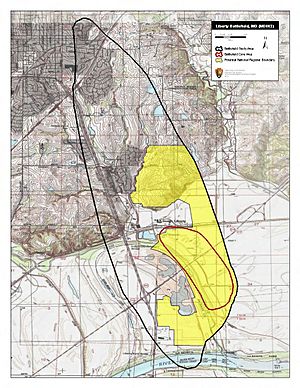Action at Blue Mills Landing facts for kids
Quick facts for kids Action at Blue Mills Landing |
|||||||
|---|---|---|---|---|---|---|---|
| Part of the Trans-Mississippi Theater of the American Civil War |
|||||||
 Map of Liberty Battlefield core and study areas by the American Battlefield Protection Program |
|||||||
|
|||||||
| Belligerents | |||||||
| Commanders and leaders | |||||||
| Units involved | |||||||
| 4th Division, Missouri State Guard |
|
||||||
| Strength | |||||||
| 3,500 | 600 | ||||||
| Casualties and losses | |||||||
| 70 | 56 | ||||||
The Action at Blue Mills Landing, also known as the Battle of Liberty, was a small but important fight during the American Civil War. It happened on September 17, 1861, in Clay County, Missouri. Union (Northern) soldiers tried to stop pro-Southern Missouri State Guard troops from crossing the Missouri River. These Southern troops were trying to join General Sterling Price at Lexington. The Union forces were not successful, and the Southern troops won this battle.
Why the Battle Happened
After winning a battle at Wilson's Creek in August, General Price wanted to take control of Missouri. Union troops were guarding the Hannibal and St. Joseph Railroad and its end point in St. Joseph, Missouri. When these Union soldiers left to fight Price's army, Southern supporters in northwestern Missouri took over St. Joseph. They also damaged the town.
On September 15, about 3,500 men from the Missouri State Guard, plus some other fighters, left St. Joseph for Lexington. That evening, General Price sent Brigadier-General David R. Atchison from Lexington. Atchison's job was to help these new soldiers cross the river near Liberty.
Union troops from the 16th Illinois Infantry and the 39th Ohio Infantry were guarding a railroad bridge. This bridge was over the Platte River in Buchanan County. The bridge had been damaged earlier. These Union troops started moving towards Liberty.
At the same time, Union Lieutenant-Colonel John Scott led a smaller group. His force had 500 men from the 3rd Iowa Infantry, about 100 Missouri Home Guards, and one small cannon. They marched from Cameron towards Liberty. Heavy rain and bad roads made their trip slow. They only moved seven miles that day. On September 16, Scott's group camped in Centerville, ten miles north of Liberty. There, he heard the sound of cannons far away.
The Battle at Blue Mills Landing
Lieutenant-Colonel Scott's troops left their camp at 2:00 A.M. on September 17. They arrived in Liberty at 7:00 A.M. By then, the Southern troops were already crossing the Missouri River at Blue Mills Landing. Lt. Colonel Scott sent 20 mounted scouts to find the enemy. He wanted to know how far along they were in crossing the river.
Near where Liberty Landing Road and Old Highway 210 are today, the rear guard of Atchison's troops waited in a hidden spot. The Union scouts rode right into this trap. Four of their men were killed, and one was badly hurt. The scouts who survived quickly rode back towards Liberty. At noon, Scott began moving all his soldiers towards the river landing.
General Atchison, who used to live in Liberty, placed his men in the bushes. They were on both sides of the road that led to the landing. Around 3:00 P.M., Scott's troops met the State Guard's lookouts. They were then attacked from both sides.
Scott's cannon crew fired two rounds of canister, which caused some damage. However, a new round of shots from the State Guards scattered or killed most of the gunners. Scott ordered his outnumbered force to fall back towards Liberty. They pulled the cannon away by hand. Atchison tried to move around the Union's right side, which led to a fierce fight. The Union soldiers kept pulling back, firing as they went. They took almost all their wounded with them. But they had to leave behind their ammunition wagon and a caisson (a cart for ammunition). The State Guard chased them for a short distance, but Atchison did not push the attack further.
Just before nightfall, Scott's troops went back to Liberty. They entered the town about an hour after the sun set. Atchison and the State Guards from northern Missouri successfully crossed the river. They joined General Price, helping him in his successful attack on Lexington. After sunset, the Union troops returned to the battlefield to get their dead soldiers.
The battle lasted about an hour. It was a clear victory for the pro-Southern Missouri State Guard.
Casualties
Nineteen Union soldiers died because of the fighting. About 80 were wounded. Three men from the Southern side were killed, and 18 were wounded. Scott and his troops went back to Liberty. They set up a hospital in Jewell Hall on the William Jewell College campus. The surviving soldiers from Scott's group buried their dead friends near Mt. Memorial Cemetery. This area is now part of the William Jewell campus. Those soldiers were later moved to the Fort Leavenworth National Cemetery in 1912.

